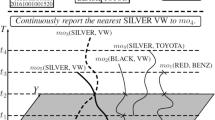Abstract
Motivated by the trend of enriching the knowledge about movement data, this chapter introduces representing and querying multi-attribute trajectories in a database system. Such a trajectory contains a sequence of time-stamped locations and a set of descriptive attributes. Multi-attribute trajectories mainly deal with attributes describing characteristics of objects, i.e., attributes that are not relevant to locations. This differs from semantic and activity trajectories in the literature that focus on location-dependent information. A range of novel queries are incurred that integrate both spatio-temporal data and attributes into the evaluation. To enhance the query performance, a hybrid and flexible index is developed to manage multi-attribute trajectories. Efficiently updating the structure is also presented. Query algorithms are proposed, accompanied with optimization strategies. Furthermore, the chapter introduces the system development, reports the performance evaluation and points out future directions.
Access this chapter
Tax calculation will be finalised at checkout
Purchases are for personal use only
Similar content being viewed by others
Notes
- 1.
Given three rectangles a, b, c, each contains a set of points inside. We aim to find the nearest point to a given point inside a. Let Max(b, a) and Min(c, a) denote the maximum and minimum distances between two rectangles. If Max(b, a) ≤ Min(c, a), then no point inside the rectangle c can be closer than a point in the rectangle b to a. As a consequence, we can omit c when searching for the nearest neighbor to a.
- 2.
The space is contained by the node but there are few or no data objects. One can also call this dead space (Tao and Papadias 2001), meaning that the area will be evaluated but few objects are there or even no object exists.
References
Alvares LO, Bogorny V, Kuijpers B, Moelans B, Fern JA, Macedo ED, Palma AT (2007) Towards semantic trajectory knowledge discovery. Data Mining and Knowl Discov
Bentley JL, Ottmann T (1979) Algorithms for reporting and counting geometric intersections. IEEE Trans Comput 28(9):643–647
Bercken J, Seeger B (2001) An evaluation of generic bulk loading techniques. In: VLDB, pp 461–470
Bercken J, Seeger B, Widmayer P (1997) A generic approach to bulk loading multidimensional index structures. In: VLDB, pp 406–415
Chakka VP, Everspaugh A, Patel JM (2003) Indexing large trajectory data sets with seti. In: CIDR
Chen Z, Tao Shen H, Zhou X, Zheng Y, Xie X (2010) Searching trajectories by locations: an efficiency study. In: SIGMOD, pp 255–266
Chen L, Cong G, Jensen CS, Wu D (2013) Spatial keyword query processing: an experimental evaluation. PVLDB 6(3):217–228
Cong G, Jensen CS, Wu D (2009) Efficient retrieval of the top-k most relevant spatial web objects. PVLDB 2(1):337–348
de Almeida VT, Güting RH (2005) Indexing the trajectories of moving objects in networks. GeoInformatica 9(1):33–60
De Felipe I, Hristidis V, Rishe N (2008) Keyword search on spatial databases. In: ICDE, pp 656–665
Dinh L, Aref WG, Mokbel MF (2010) Spatio-temporal access methods: part 2 (2003–2010). IEEE Data Eng Bull 33(2):46–55
Forlizzi L, Güting RH, Nardelli E, Schneider M (2000) A data model and data structures for moving objects databases. In: SIGMOD, pp 319–330
Frentzos E (2003) Indexing objects moving on fixed networks. In: SSTD, pp 289–305
Frentzos E, Gratsias K, Pelekis N, Theodoridis Y (2005) Nearest neighbor search on moving object trajectories. In: SSTD, pp 328–345
Frentzos E, Gratsias K, Pelekis N, Theodoridis Y (2007) Algorithms for nearest neighbor search on moving object trajectories. GeoInformatica 11(2):159–193
Güting RH, Schneider M (2005) Moving objects databases. Morgan Kaufmann, Amsterdam
Güting RH, Böhlen MH, Erwig M, Jensen CS, Lorentzos NA, Schneider M, Vazirgiannis M (2000) A foundation for representing and querying moving objects. ACM TODS 25(1):1–42
Güting RH, Behr T, Düntgen C (2010a) SECONDO: a platform for moving objects database research and for publishing and integrating research implementations. IEEE Data Eng Bull 33(2):56–63
Güting RH, Behr T, Xu J (2010b) Efficient k-nearest neighbor search on moving object trajectories. VLDB J 19(5):687–714
Güting RH, Valdés F, Damiani ML (2015) Symbolic trajectories. ACM Trans Spat Algorithms Syst 1(2):Article 7
Hadjieleftheriou M, Kollios G, Tsotras VJ, Gunopulos D (2002) Efficient indexing of spatiotemporal objects. In: EDBT, pp 251–268
Han Y, Wang L, Zhang Y, Zhang W, Lin X (2015) Spatial keyword range search on trajectories. In: DASFAA, pp 223–240
Jensen CS, Lu H, Yang B (2009) Indexing the trajectories of moving objects in symbolic indoor space. In: SSTD, pp 208–227
Jeung H, Yiu ML, Zhou X, Jensen CS, Shen HT (2008) Discovery of convoys in trajectory databases. PVLDB 1(1):1068–1080
Lange R, Dürr F, Rothermel K (2011) Efficient real-time trajectory tracking. VLDB J 20(5):671–694
Lee T, Park J, Lee S, et al (2015) Processing and optimizing main memory spatial-keyword queries. PVLDB 9(3):132–143
Long C, Wong RCW, Jagadish HV (2013) Direction-preserving trajectory simplification. PVLDB 6(10):949–960
Lu H, Cao X, Jensen CS (2012) A foundation for efficient indoor distance-aware query processing. In: ICDE, pp 438–449
Mauroux PC, Wu E, Madden S (2010) Trajstore: an adaptive storage system for very large trajectory data sets. In: ICDE, pp 109–120
Parent C, Spaccapietra S, Renso C, Andrienko GL, Andrienko NV, Bogorny V, Damiani ML, Gkoulalas-Divanis A, de Macêdo JAF, Pelekis N, Theodoridis Y, Yan Z (2013) Semantic trajectories modeling and analysis. ACM Comput Surv 45(4):42
Pelanis M, Saltenis S, Jensen CS (2006) Indexing the past, present, and anticipated future positions of moving objects. ACM TODS 31(1):255–298
Pfoser D, Jensen CS (2003) Indexing of network constrained moving objects. In: GIS, pp 25–32
Pfoser D, Jensen CS (2000) Novel approaches in query processing for moving object trajectories. In: VLDB, pp 395–406
Piorkowski M, Sarafijanovic-Djukic N, Grossglauser M CRAWDAD dataset epfl/mobility (v. 24 Feb 2009). http://crawdad.org/epfl/mobility/20090224
Popa IS, Zeitouni K, Oria V, Barth D, Vial S Indexing in-network trajectory flows. VLDB J 20(5):643–669 (2011)
Rasetic S, Sander J, Elding J, Nascimento MA (2005) A trajectory splitting model for efficient spatio-temporal indexing. In: VLDB, pp 934–945
Song Z, Roussopoulos N (2003) Seb-tree: an approach to index continuously moving objects. In: MDM, pp 340–344
Su Y, Wu Y, Chen ALP (2007) Monitoring heterogeneous nearest neighbors for moving objects considering location-independent attributes. In: DASFAA, pp 300–312
Su H, Zheng K, Zeng K, Huang J, Sadiq SW, Yuan NJ, Zhou X (2015) Making sense of trajectory data: a partition-and-summarization approach. In: ICDE, pp 963–974
Tao Y, Papadias D (2001) Mv3r-tree: a spatio-temporal access method for timestamp and interval queries. In: VLDB, pp 431–440
Tong Y, Chen Y, Zhou Z, Chen L, Wang J, Yang Q, Ye J, Lv W (2017) The simpler the better: a unified approach to predicting original taxi demands based on large-scale online platforms. In: ACM SIGKDD, pp 1653–1662
Tong Y, Zeng Y, Zhou Z, Chen L, Ye J, Xu K (2018) A unified approach to route planning for shared mobility. PVLDB 11(11):1633–1646
Tzoumas K, Yiu ML, Jensen CS (2009) Workload-aware indexing of continuously moving objects. PVLDB 2(1):1186–1197
Valdés F, Güting RH (2014) Index-supported pattern matching on symbolic trajectories. In: ACM SIGSPATIAL, pp 53–62
Valdés F, Güting RH (2017) Index-supported pattern matching on tuples of time-dependent values. GeoInformatica 21(3):429–458
Valdés F, Güting RH (2019) A framework for efficient multi-attribute movement data analysis. VLDB J 28(4):427–449
Wang H, Zimmermann R (2011) Processing of continuous location-based range queries on moving objects in road networks. IEEE Trans Knowl Data Eng 23(7):1065–1078
Wang W, Xu J (2017) A tool for 3d visualizing moving objects. In: APWeb-WAIM, pp 353–357
Wang X, Zhang Y, Zhang W, Lin X, Huang Z (2016) SKYPE: top-k spatial-keyword publish/subscribe over sliding window. PVLDB 9(7):588–599
Wei X, Xu J (2018) MDBF: a tool for monitoring database files. In: ER Workshops, pp 54–58
Wu D, Yiu ML, Cong G, Jensen CS (2012) Joint top-k spatial keyword query processing. IEEE Trans Knowl Data Eng 24(10):1889–1903
Xu J, Güting RH (2012) Mwgen: a mini world generator. In: IEEE MDM, pp 258–267
Xu J, Güting RH (2013) A generic data model for moving objects. GeoInformatica 17(1):125–172
Xu J, Güting RH (2017) Query and animate multi-attribute trajectory data. In: ACM CIKM, pp 2551–2554
Xu J, Güting RH, Qin X (2015a) Gmobench: benchmarking generic moving objects. GeoInformatica 19(2):227–276
Xu J, Güting RH, Zheng Y (2015b) The TM-RTree: an index on generic moving objects for range queries. GeoInformatica 19(3):487–524
Xu J, Güting RH, Gao Y (2018a) Continuous k nearest neighbor queries over large multi-attribute trajectories: a systematic approach. GeoInformatica 22(4):723–766
Xu J, Lu H, Güting RH (2018b) Range queries on multi-attribute trajectories. IEEE Trans Knowl Data Eng 30(6):1206–1211
Yan Z, Chakraborty D, Parent C, Spaccapietra S, Aberer K (2011) Semitri: a framework for semantic annotation of heterogeneous trajectories. In: EDBT, pp 259–270
Yao B, Xiao X, Li F, Wu Y (2014) Dynamic monitoring of optimal locations in road network databases. VLDB J 23(5):697–720
Zhang C, Han J, Shou L, Lu J, La Porta TF (2014) Splitter: mining fine-grained sequential patterns in semantic trajectories. PVLDB 7(9):769–780
Zheng K, Su H (2015) Go beyond raw trajectory data: quality and semantics. IEEE Data Eng Bull 38(2):27–34
Zheng Y, Zhou X (2011) Computing with spatial trajectories. Springer, New York
Zheng K, Shang S, Yuan NJ, Yang Y (2013a) Towards efficient search for activity trajectories. In: ICDE, pp 230–241
Zheng K, Zheng Y, Yuan NJ, Shang S (2013b) On discovery of gathering patterns from trajectories. In: ICDE, pp 242–253
Zheng B, Yuan NJ, Zheng K, Xie X, Sadiq SW, Zhou X (2015) Approximate keyword search in semantic trajectory database. In: ICDE, pp 975–986
Acknowledgements
This work is supported by NSFC under grants 61972198, Natural Science Foundation of Jiangsu Province of China under grants BK20191273 and National Key Research and Development Plan of China (2018YFB1003902). Thanks Weiwei Wang for developing the 3-D visualization tool and Xiangyu Wei for developing the monitoring tool.
Author information
Authors and Affiliations
Corresponding author
Editor information
Editors and Affiliations
Rights and permissions
Copyright information
© 2021 Springer Nature Switzerland AG
About this chapter
Cite this chapter
Xu, J. (2021). Multi-attribute Trajectory Data Management. In: Werner, M., Chiang, YY. (eds) Handbook of Big Geospatial Data. Springer, Cham. https://doi.org/10.1007/978-3-030-55462-0_9
Download citation
DOI: https://doi.org/10.1007/978-3-030-55462-0_9
Published:
Publisher Name: Springer, Cham
Print ISBN: 978-3-030-55461-3
Online ISBN: 978-3-030-55462-0
eBook Packages: Mathematics and StatisticsMathematics and Statistics (R0)




